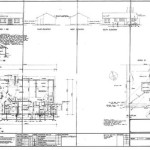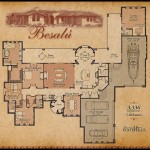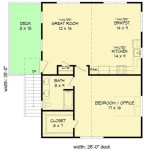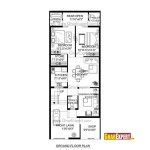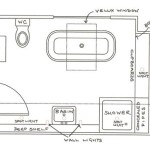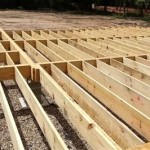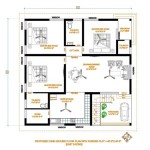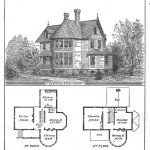Single-Level House Floor Plans: Advantages, Considerations, and Design Elements
Single-level house floor plans, often referred to as ranch-style or one-story homes, offer a multitude of benefits and cater to a diverse range of homeowners. Their defining characteristic is the arrangement of all living spaces on a single floor, eliminating the need for stairs. This feature alone contributes significantly to their appeal, particularly for individuals with mobility limitations, families with young children, and those seeking ease of maintenance and aging-in-place design. This article delves into the advantages, considerations, and design elements associated with single-level house floor plans.
Accessibility and Universal Design
The inherent accessibility of single-level homes is a primary advantage. The absence of stairs makes them ideal for individuals with mobility impairments, including those using wheelchairs, walkers, or other assistive devices. This feature also benefits families with young children, reducing the risk of falls. Furthermore, single-level living aligns seamlessly with the principles of universal design, which aims to create spaces that are usable by people of all ages and abilities. Universal design principles can be further integrated into single-level homes by incorporating wider doorways, roll-in showers, grab bars, and lever-handled door hardware. The layout allows for easier navigation throughout the home for tasks such as cleaning, grocery shopping, and other common household activities. This ease of movement contributes to greater independence and quality of life.
Beyond the elimination of stairs, accessibility considerations extend to the layout and design of individual rooms. For example, kitchens can be designed with adjustable-height countertops and under-sink knee space to accommodate wheelchair users. Bathrooms can feature curbless showers and ample maneuvering space. Hallways should be wide enough to allow comfortable passage for assistive devices. Outdoor access can also be improved by incorporating ramps or gently sloped walkways leading to the entrance. These features enhance the usability and comfort of the home for individuals with diverse needs.
The long-term benefits of an accessible home are significant. As homeowners age or experience changes in their physical abilities, they can remain in their homes comfortably and safely. This can reduce the need for costly renovations or relocation to assisted living facilities. Moreover, an accessible home can increase its resale value, attracting a wider range of potential buyers.
Cost and Construction Considerations
While single-level homes offer numerous advantages, it's crucial to consider the cost and construction implications. Generally, single-level homes require a larger footprint than multi-story homes of comparable square footage. This translates to a larger foundation, more roofing material, and potentially higher land costs. However, there are offsetting factors to consider. The simplified construction process, with all living spaces on one level, can streamline the building process and potentially reduce labor costs. Moreover, heating and cooling systems may be more efficient in single-level homes due to the absence of vertical air stratification.
Foundation costs are a significant factor. Depending on the soil conditions and local building codes, the foundation may require extensive excavation and reinforcement. Slab-on-grade foundations are common in single-level homes, but crawl spaces or basements can also be incorporated. Crawl spaces provide access to plumbing and electrical systems for maintenance and repairs, while basements can offer additional living space or storage. The choice of foundation type will impact the overall cost and construction timeline.
Roofing costs are also influenced by the larger area covered by a single-level home. However, the simpler roof design, typically with fewer gables and dormers, can offset the increased material costs. Energy efficiency is another crucial consideration. Proper insulation and the strategic placement of windows and doors can minimize heat loss in the winter and heat gain in the summer. This can lead to lower energy bills and a more comfortable living environment. Investing in energy-efficient appliances and HVAC systems can further reduce long-term operating costs.
Lot size and orientation play a critical role in the design and construction of single-level homes. A larger lot is typically required to accommodate the increased footprint. The orientation of the home should be carefully considered to maximize natural light and minimize exposure to harsh sunlight. Passive solar design principles can be incorporated to optimize energy efficiency and reduce reliance on artificial heating and cooling.
Design and Layout Options
Single-level floor plans offer a variety of design and layout options to suit different lifestyles and preferences. Open-concept layouts are popular, creating a seamless flow between living areas, dining areas, and kitchens. This fosters a sense of spaciousness and encourages social interaction. However, some homeowners prefer more defined spaces for privacy and noise control. The key is to strike a balance between open flow and defined areas.
Zoning is an important consideration in single-level home design. Separating the sleeping areas from the living areas can create a more peaceful and private environment. The master suite can be located at one end of the home, while the guest bedrooms and bathrooms are located at the other end. This creates a clear separation between the owner's living space and the guest area. The kitchen is often located near the dining area and living room for easy access and entertaining.
Outdoor living spaces are an integral part of single-level home design. Patios, decks, and porches can extend the living area and provide opportunities for outdoor relaxation and entertaining. These spaces can be accessed directly from the living room, dining room, or master bedroom. Landscaping can further enhance the outdoor living experience, creating a private and aesthetically pleasing environment. Incorporating features such as outdoor kitchens, fireplaces, and seating areas can transform the backyard into an extension of the home.
Storage is often a concern in single-level homes, particularly if there is no basement. Clever storage solutions can maximize space and minimize clutter. Built-in shelves, cabinets, and drawers can be incorporated into closets, hallways, and living areas. Attics can be used for storage, but access may be limited. Carports and garages can provide additional storage space for vehicles, tools, and outdoor equipment. Optimizing storage solutions is essential for maintaining a comfortable and organized living environment.
Interior design choices also play a crucial role in enhancing the aesthetics and functionality of single-level homes. Natural light is a key element. Large windows and skylights can bring in plenty of natural light, making the home feel brighter and more spacious. Neutral color palettes can create a calming and inviting atmosphere. Accenting with pops of color can add personality and visual interest. Furniture should be carefully selected to fit the scale of the rooms and maximize space. Minimizing clutter and maintaining a clean and organized environment is essential for creating a comfortable and inviting home.
Ultimately, the design and layout of a single-level home should reflect the homeowner's individual needs and preferences. Careful planning and attention to detail can create a functional, comfortable, and aesthetically pleasing living space that meets the demands of modern living while providing the long-term benefits of accessibility and ease of maintenance.

One Story House Plans

House Plan 77400 Ranch Style With 1311 Sq Ft 3 Bed 2 Bath

Our Favorite Unique One Story House Plans Blog Dreamhomesource Com

Unique One Story House Plans Monster

Must Have One Story Open Floor Plans Blog Eplans Com

Best One Story House Plans And Ranch Style Designs

One Story House Plan Examples

1 Story House Plans One Modern Luxury Home Floor

Unique One Story House Plans Monster

Stylish One Story House Plans Blog Eplans Com

